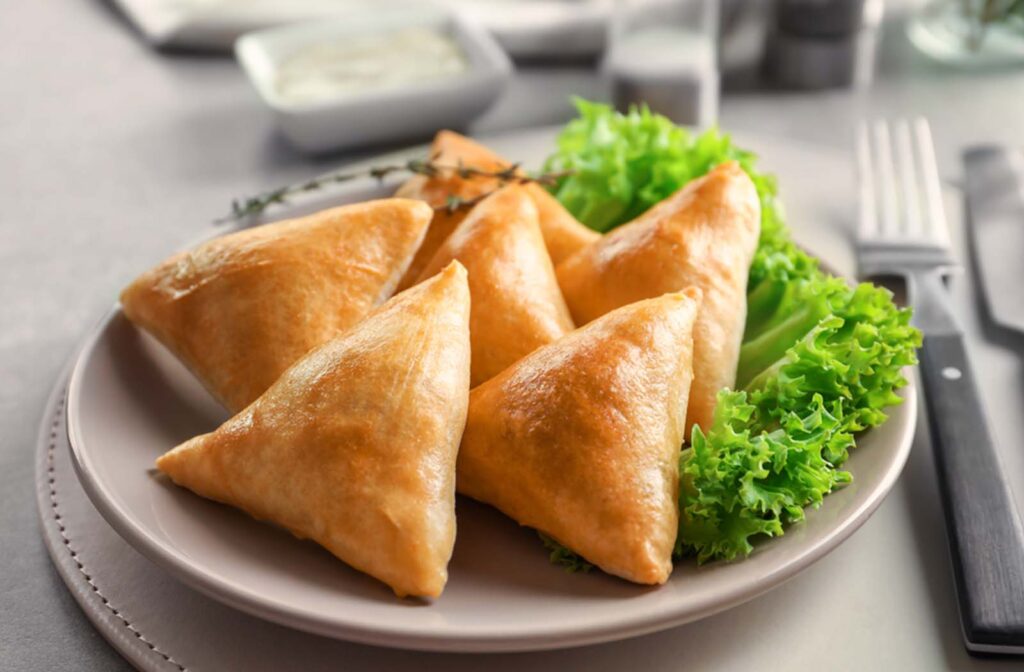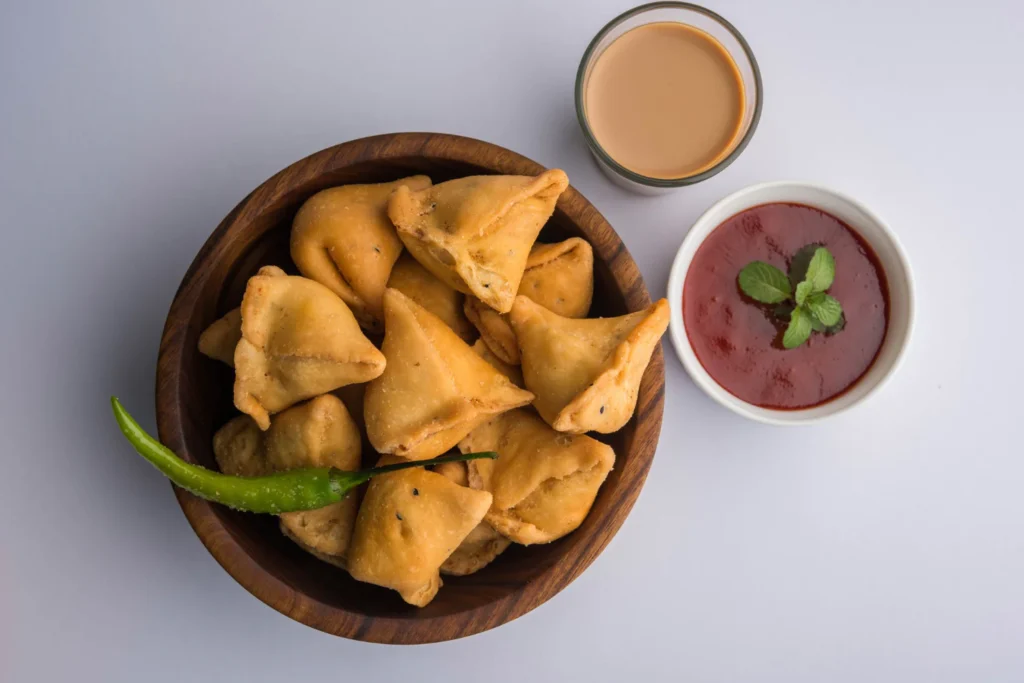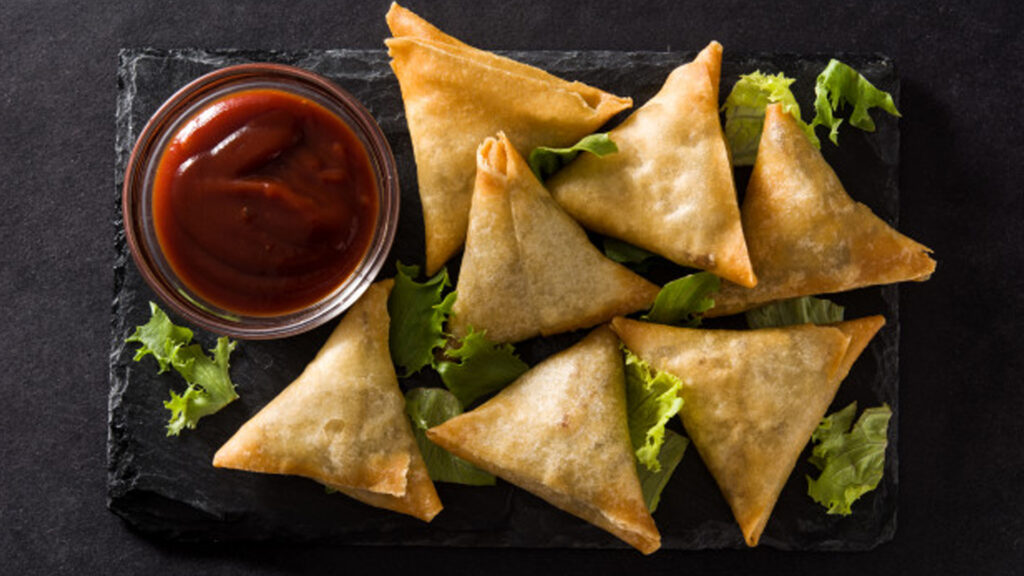It may be hard to find more irresistible; it is difficult to compete with more flavor, nor for that matter, with any more versatility than a samosas. From the packed streets of Delhi to overflowing markets of Karachi and beyond, the samosa finds its place across continents and generations. It is comfort food; it is celebration; in its golden, crispy wrapper and warm, spiced filling, it is community-centric. It’s just great how the samosa traveled out of South Asia, carrying on to various cultures while assimilating as much flavor, techniques, and innovations along the way.

It started out to be the most popular street food, evolved beyond just being a source of only nutrition and with it also being a symbol of heritage social bonding, standing for its usage in many cultural and festivals.
Tracing the Roots: A Journey in the History of the Samosa
This samosa’s tale starts way back in ancient times of the Middle East, way back to the 10th century with its first early editions of this pastry. Samosa or samosa is also encountered some references in Persian and Arabic literature where it originated largely as a food in royal courts, thus the earlier versions are said to be crescent-shaped and filled with ground meat, nuts, and dried fruits. Its portability makes it one of the popular items taken by travelers and merchants for long voyages.
Being quite large, it easily reached Central Asia from where it spread throughout and further on to the Indian subcontinent during the Middle Ages, with the routes so wide and lengthy. This time it was introduced to the Indian public by merchants, traders, and travelers but this time with a name in Persian called “samosa” from which evolved a heartier and more spicy form, reflecting the very heart of Indian culinary tradition-they took center stage because of local spices and ingredients used.
The Mughal emperors who relished in these feasts started consuming samosas as part of the grand feasts. Flavors and textures suited the taste of the Mughals who loved rich and elaborate food. Gradually, it transformed from a royal snack item to this roadside phenomenon available to people of all classes, which is now an Indian snacking item per excellence.
Anatomy of the Perfect Samosa: Flavors and Textures
It is especially the flavors mixed with textures that make the beauty of the samosa. This center can be divided into three; the dough, the filling, and cooking.
Dough: The outer crust of the samosa is made from a dough of all-purpose flour mixed with a little oil or ghee which gives this very rich flavor and crisp texture. It was kneaded to a pretty firm consistency, so it assumed the shape when frying. After kneading, it was left to rest for a while in order to help in developing gluten, creating texture once it is satisfyingly crisp when fried.
Filling: With a traditional filling, potatoes and peas are added to the preparation. However, one given an additional crunch of flavors here due to cumin, coriander, garam masala, and turmeric. In freshness and the added herbs and the greens of cilantro provides it with brightness. Use of onion, garlic, ginger, or even some regional variety of green chilies could add different degrees of complexity. With minced meat included as well as spice and vegetable when preparing samosas by use of meat, it provides a filling that is not enjoyed by the more population.

-Frying will comprise of a deep-fry procedure where the dough-covered samosa gets its golden-brown crispy outside. Most importantly, to get this right, the frying temperature has to be on the spot, not to end up burning but to consume much oil. It will set at that frying temperature into a crispy crunch on the outside flaky exterior with the soft spiced fillings inside. As for taste, it tastes crunchy from the shell’s side and soft from filling’s side, making that a scrumptious balance between shell and filling of a satisfaction for every little morsel taken inside.
Regional Varieties of Samosas
From the South Asian regions, unique local varieties have been invented using regional ingredients and tastes. The best-known varieties include: North Indian Samosas
They are too large in size, and hot potato mixture is the filling of these samosas. Garam masala, cumin, and green chili added in the North Indian samosa makes it too spicy for anyone’s palate. It is mostly taken with tamarind or mint-coriander chutneys. Heavy and better to be enjoyed as tea-time snacks.
Punjabi Samosas: A Punjabi samosa can even have paneer or minced meat for a more sumptuous, meaty filling. That kind of variety is only common in Punjabi cooking that embraces massive flavors and decadent servings. There may even be some amchur in Punjabi samosas to give that tang of dried mango powder and dipped in yogurt.
Gujarati Samosas: Gujarati samosas are smaller. They are called “Patti samosas.” The sweet filling has hints of spices and nuts or raisins. Regional spices like ajwain (carom seeds) may be present, and they serve with a sweet-and-spicy chutney, which completes the flavor of the dish.
Bengali Singaram: The most popular variant is “Sinagra” in Bengal. Bengali Shingaras are smaller in size and are stuffed with potatoes, cauliflower, and peanuts seasoned with pinch photon. This is the special five-spice mix for Bengali cuisine. It has a thinner crust; hence each bite tastes good with texture and flavor balance. It is taken during festivals and is widely sold in street food stalls.
Pakistan Samosas: Pakistani versions are hotter and fillings here include minced beef or lamb, and even minced chicken. The Pakistani samosa carries a spicier flavor profile with more dominion from coriander and cumin and always includes the typical addition of green chili flavor. In Pakistan, Pakistani samosas are a staple dish for Iftar celebrations during Ramadan. Ingredients are also added to dough.
The Afghan samosas are slightly similar to boulani but stuffed with potatoes, leeks, or pumpkin. Largely fried or baked, usually stuffed and seasoned with spices peculiar and characteristic of Afghan spices and herbs-where a large amount of agricultural activity was discovered.
As would be expected, a taste apart from others by each of the regional varieties of the samosa stands out distinctly because it seems that this favorite snack happens to be quite versatile and accommodating.
Here, local tastes along with influences from various cultures and ways through which changing times affected changes in cuisine is reflected.

For South Asians, the samosa is a far greater concept than a snack to consume. It has developed to become an icon of social and cultural identity. It is in the busiest markets that street vendors fill thousands of samosas in India and Pakistan. Fragrant spices and hot oil mix into dough sent to the air while it is being fried. These nations regard the snack as upholding values that typify friendship and unison.
Holidays and Celebrations
Samosas should always appear when festivals or parties are conducted. For example, in India, during Diwali and Holi, samosas need to be present on the table. In Pakistan, any time when Ramadan arrives near, when people at sunset time break their fasting, it is referred as Iftar. In the Iftar, it goes without saying that house owners keep samosas because these stuffed with minced meat or potatoes, hence, implying riches and prosperity. At such times, this presentation goes to show that culture regarding people affirms hospitality and the society.
Tea Time Tradition
Tea time culture, particularly in India and Pakistan, is very much related to samosas. Indeed, this combination of a spicy hot samosa with a cup of chai is a very comforting combination especially during the monsoon seasons. In fact, in British-Asian communities, the pairing of samosas with tea is so much loved because of that nostalgic touch. The greatness about samosas is how they can become an icebreaker between friends and family members over shared experiences and flavors.
Global Impact
Within South Asia, the presence of the samosa continues to be quite influential. It has now become one of the most favorite snack items within the British-Asian community but has also found its way into the mainstream British culture. They can be found in most supermarkets, street food markets, and pubs because they are both the old and the new. Actually, the regional samosa calls it a sambuusa. It is all about what is accessible to its region and widely found in a particular region. From that, the diversity in this global adaptation of making a samosa is more than enough.
How to make the perfect samosa in the comfort of your own home is almost always a satiating exercise. Here is the step-by-step guide for the original potato-pea samosa:
Ingredients
Dough:
2 cups all-purpose flour
4 tablespoons oil or ghee
1/2 teaspoon salt
Water as needed
Filling
2 medium potatoes, boiled and mashed
½ cup green peas
1 tablespoon oil
1 tsp cumin seeds
– 1/2 teaspoon coriander powder
– 1/2 teaspoon turmeric powder
– 1/2 teaspoon garam masala
-Salt to taste
– Fresh cilantro, chopped
–
How to prepare
1. Prepare the dough: Combine all the salt and flour into a mixite jar. Gradually add the oil/ghee so that it well rubs into the flour till a breadcrumb-like state is seen. Add a little at a time from the waters till a thick dough arises. Knead for 3-5 minutes until dough turns out smooth. Put it in a damp cloth, and rest for 30 minutes. Resting for 30 minutes gives time for the gluten development within the dough. The gluten development gives dough elasticity.
Stuffing preparation: put oil in a pan having medium heat. Put cumin seeds, which splutters and then add the mashed potatoes along with green peas, spices, mix all together. Cook for around 5 minutes, and stir the mixture occasionally so it does not stick. Salt to taste, add chopped cilantro, and let the stuffing cool before its use.
Step 3: Putting the Samosas Together Take small pieces of rested dough, marble-sized balls. Roll each marble-sized ball into a very thin oval about 6 inches long. Cut the oval in half to create two semi-circles. Take one of the semi-circles and bring the straight edges together to form a cone. Moisten the seam and close it. Take a spoonful of the potato-pea mixture, fill it into the cone, close the top edge by pinching, and seal that seam well so there aren’t any gaps.
Deep fry
Heat the oil in the deep-frying pan or the wok over medium fire. For checking whether it is ready, drop some small portion of dough. When the dough sizzles and rises to the surface, the oil becomes hot. Fry in batches without overcrowding the pan Fry till it turns to a golden and crispy color for about 5-7 minutes. Take them out from the oil with a slotted spoon and place on paper towels to drain.
Enjoy best hot with mint-coriander or tamarind chutney.
New Twists and Fusion Samosas
These, traveling through cultures across the world, were turned uniquely into samosas themselves. With such creative and tasty fillings from chefs or home cooks, they succeeded in reinventing samosas with options to suit newer tastes and tastes.
Cheese and Jalapeño Samosas: Inspired from the Mexican flavor, gooey cheese and the kick of the jalapeno for an aromatic mix. The molten cheese provides a contradictory pleasure to the crispy out layer, which makes these items extremely popular at parties.
Chocolate and Nut Samosas Chocolate and nut-filled dessert samosas coated with a sweet, creamy chocolate mixture along with chopped nuts. That makes a perfect celebratory delight simply dusted with some powdered sugar just before serving.
Mexican Samosas: It combines black beans and corn in a melted cheese mix; it is the combination of Mexican food with the way a samosa is traditionally done. They can be crowned with avocado or served along with salsa for a highly exciting experience that transcends borders of cultures.
Vegan and Gluten-Free Versions: The growing specificity in diets has made samosas be altered to suit the diet while still remaining vegan and gluten-free friendly. Some of the flours, that have replaced the traditional wheat dough-making, are gluten-free chickpea or rice flours while filling comprises of using a variety of vegetables and spices; these versions remain healthy and never lack in flavor.
They are the dynamic aspect of food culture because these dishes can evolve in so many ways without losing their heart and soul.
Healthy Samosas: Baked and Air-Fried Options
For those who do not want to let go of enjoying their samosas but reduce the calorie count, then baking and air-frying are good alternatives that can be done without giving away flavor.
Baked Samosas: Bake the samosas with oil brushed on, rather than frying. That makes them crispy, but by no means nearly as oily. You can add spices to the oil for an added flavor, but then with a lot less unhealthy oil.
Air Fryer Samosas- one is crispy in texture, but it carries considerably lesser calories as compared to deep fry. Set your air fryer, cook your samosas in batches, almost for 12 to 15 minutes at 350F/175 C and turn them in the middle to reduce the amount of fats, but it’ll still give out the deliciousness of your samosas.
These are guilt-free indulgences in the samosas especially at a time when people are finding a need to eat healthily. Healthier samosas can be tastefully flavored just like a normal samosa would thus be over snack time favorite treat over.
Perfect Pairing: Chutneys and Beverages
The perfect accompanies to complement the flavors of the samosa are these:
Mint-Coriander Chutney: Fresh mint leaves, coriander, green chilies, and squeeze of lime juice give cooling to the spiciness of the samosa.
Tamarind Chutney: The best way to explain it is that it is sweetness-and-sour because of tamarind, jaggery, and spices; just completes the overall flavor profile, which completes the whole experience.
Masala Chai: For those who do not understand South Asians, masala chai is nothing less than the perfect accompaniment to samosas. Every bite goes warm and spicy with masala chai. When these are relished accompanied by masala chai, it makes a perfect comfort that’s even worth savoring during afternoon tea settings.
Lassi: Lassi is just yogurt drink but may be served either sweet or savory. It can be refreshing and cool, but lassi can in fact neutralize the heat of the samosa so that it perfectly complements the samosa, thereby, it’s perfect to eat when it’s a hot weather during summer months.
These are the ways on how these combinations enhance not just the taste but also provides an all-around dining setting wherein friends and family are welcome to have a session for food.
Global Impact of Samosas
Samosa has gone around the world, and many variations have come out along the way. The versatility of the snack in terms of portability and taste had made it popular in quite a number of countries from its original cultural background
East Africa: Samosas are street food in Kenya and Tanzania. It is mostly spiced meat served with a spicy sauce. The Indian and Arab cuisines blended together to create unique variations that reflect the local palate.
United Kingdom: The samosa has become an indispensable part of British food culture, especially in multicultural cities. Samosas are very easily available in supermarkets and parties. The British-Asian community has adopted the samosas in a big way, giving innovative fillings and flavors to the dish.
Middle East: In Egypt and Lebanon, similar pastries are popular under the name “sambuusa,” filled with spiced meats or vegetables. These pastries reflect the culinary traditions of the region, often served during festivities and family gatherings.
The adaptation in the West: In restaurants and cafes of the West, the samosa is seen as an increasingly popular appetizer and the fusion is often found together. Each chef innovates his version by altering the stuffing according to current tastes; be it a truffle oil-infused potato samosas or the spicy chicken samosas with the kick of sriracha.
Thus, the way samosas blend with each culture with much ease still maintain the identity of what they have come to signify.
Conclusion
This is a testament to its universal appeal, from the Persian palaces to the Indian streets and then the continents across. Its flavor layers, inviting texture, and adaptability have made this snack favorite for centuries. As samosas continue their evolution and inspire new creations, they are a culinary icon that brings people, flavors, and stories together.
Whether enjoyed at a bustling bazaar, at a family gathering, or in the trendy cafes, simple samosas that transcend borders point toward love for good food and shared experiences. It being adapted and evolved in that process yet retaining its heart speaks to the culinary traditions, reminding us that it is not just for subsistence but about connection, culture, and shared joy through the flavors that unite.
In the final analysis, the samosa is something more than just a snack; it’s a real celebration of heritage, creativity, and community, actually the true tapestry of the world.



Discover the Most Delicious Samosas: 100% Guide to Perfectly Spiced and Crispy Indian Snacks
ajnvpqfxci
jnvpqfxci http://www.g003n5e3r65ykkcky4h73d48b37s1lk9s.org/
[url=http://www.g003n5e3r65ykkcky4h73d48b37s1lk9s.org/]ujnvpqfxci[/url]
Thank you for your sharing. I am worried that I lack creative ideas. It is your article that makes me full of hope. Thank you. But, I have a question, can you help me?